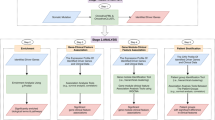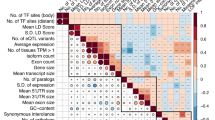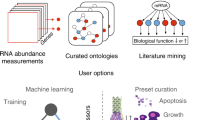Abstract
Mutual exclusivity analyses provide an effective tool to identify driver genes from passenger genes for cancer studies. Various algorithms have been developed for the detection of mutual exclusivity, but controlling false positive and improving accuracy remain challenging. We propose a forward selection algorithm for identification of mutually exclusive gene sets (FSME) in this paper. The method includes an initial search of seed pair of mutually exclusive (ME) genes and subsequently including more genes into the current ME set. Simulations demonstrated that, compared to recently published approaches (i.e., CoMEt, WExT, and MEGSA), FSME could provide higher precision or recall rate to identify ME gene sets, and had superior control of false positive rates. With application to TCGA real data sets for AML, BRCA, and GBM, we confirmed that FSME can be utilized to discover cancer driver genes.
Key points
-
Mutual exclusivity observed in cancer genome can be used to discover carcinogenic driver genes.
-
FSME is a novel de novo algorithm to identify mutually exclusive mutation genes.
-
Compared to current state-of-art de novo approaches, FSME could provide higher precision or recall rate to identify ME gene sets, and have superior control of false positive rates.
This is a preview of subscription content, access via your institution
Access options
Subscribe to this journal
Receive 12 print issues and online access
$259.00 per year
only $21.58 per issue
Buy this article
- Purchase on Springer Link
- Instant access to full article PDF
Prices may be subject to local taxes which are calculated during checkout





Similar content being viewed by others
Data availability
The FSME is implemented in R, the source code and relevant materials are available at http://home.ustc.edu.cn/~zeyuzh/.
References
Deng Y, Luo S, Deng C, Luo T, Yin W, Zhang H, et al. Identifying mutual exclusivity across cancer genomes: computational approaches to discover genetic interaction and reveal tumor vulnerability. Brief Bioinform. 2019;20:254–66.
Ciriello G, Cerami E, Sander C, Schultz N. Mutual exclusivity analysis identifies oncogenic network modules. Genome Res. 2012;22:398–406.
Babur Ö, Gönen M, Aksoy BA, Schultz N, Ciriello G, Sander C, et al. Systematic identification of cancer driving signaling pathways based on mutual exclusivity of genomic alterations. Genome Biol. 2015;16:45–54.
Leiserson MDM, Reyna MA, Raphael BJ. A weighted exact test for mutually exclusive mutations in cancer. Bioinformatics. 2016;32:i736–45.
Hua X, Hyland PL, Huang J, Song L, Zhu B, Caporaso NE, et al. MEGSA: a powerful and flexible framework for analyzing mutual exclusivity of tumor mutations. Am J Hum Genet. 2016;98:442–55.
Miller CA, Settle SH, Sulman EP, Aldape KD, Milosavljevic A. Discovering functional modules by identifying recurrent and mutually exclusive mutational patterns in tumors. BMC Med Genomics. 2011;4:34–44.
Canisius S, Martens JWM, Wessels LFA. A novel independence test for somatic alterations in cancer shows that biology drives mutual exclusivity but chance explains most co-occurrence. Genome Biol. 2016;17:261–77.
Kim Y-A, Cho D-Y, Dao P, Przytycka TM. MEMCover: integrated analysis of mutual exclusivity and functional network reveals dysregulated pathways across multiple cancer types. Bioinformatics. 2015;31:i284–92.
Song J, Peng W, Wang F. An Entropy-based method for identifying mutual exclusive driver genes in cancer. IEEE/ACM Trans Comput Biol Bioinforma. 2020;17:758–68.
Pulido-Tamayo S, Weytjens B, De Maeyer D, Marchal K. SSA-ME detection of cancer driver genes using mutual exclusivity by small subnetwork analysis. Sci Rep. 2016;6:36257.
Kim Y-A, Madan S, Przytycka TM. WeSME: uncovering mutual exclusivity of cancer drivers and beyond. Bioinformatics. 2017;33:814–21.
Dao P, Kim Y-A, Wojtowicz D, Madan S, Sharan R, Przytycka TM. BeWith: a Between-Within method to discover relationships between cancer modules via integrated analysis of mutual exclusivity, co-occurrence and functional interactions. PLoS Comput Biol. 2017;13:e1005695.
Leiserson MDM, Blokh D, Sharan R, Raphael BJ. Simultaneous identification of multiple driver pathways in cancer. PLoS Comput Biol. 2013;9:e1003054.
Vandin F, Upfal E, Raphael BJ. De novo discovery of mutated driver pathways in cancer. Genome Res. 2012;22:375–85.
Leiserson MDM, Wu H-T, Vandin F, Raphael BJ. CoMEt: a statistical approach to identify combinations of mutually exclusive alterations in cancer. Genome Biol. 2015;16:160–79.
Anderson WF, Rosenberg PS, Prat A, Perou CM, Sherman ME. How many etiological subtypes of breast cancer: two, three, four, or more? J Natl Cancer Inst. 2014;106:dju165.
Hastie T, Tibshirani R, Friedman J. The elements of statistical learning: data mining, inference, and prediction. 2nd ed. New York: Springer; 2009.
Lawrence MS, Stojanov P, Mermel CH, Robinson JT, Garraway LA, Golub TR, et al. Discovery and saturation analysis of cancer genes across 21 tumour types. Nature. 2014;505:495–501.
Gu R, Yang X, Wei H. Molecular landscape and targeted therapy of acute myeloid leukemia. Biomark Res. 2018;6:32–9.
Jiang Y, Yu K, Zuo W, Peng W, Shao Z. GATA3 mutations define a unique subtype of luminal-like breast cancer with improved survival. Cancer. 2014;120:1329–37.
Nobusawa S, Watanabe T, Kleihues P, Ohgaki H. IDH1 mutations as molecular signature and predictive factor of secondary glioblastomas. Clin Cancer Res. 2009;15:6002–7.
Koul D. PTEN signaling pathways in glioblastoma. Cancer Biol Ther. 2008;7:1321–5.
Verhaak RGW, Hoadley KA, Purdom E, Wang V, Qi Y, Wilkerson MD, et al. Integrated genomic analysis identifies clinically relevant subtypes of glioblastoma characterized by abnormalities in PDGFRA, IDH1, EGFR, and NF1. Cancer Cell. 2010;17:98–110.
Taskesen E, Bullinger L, Corbacioglu A, Sanders MA, Erpelinck CAJ, Wouters BJ, et al. Prognostic impact, concurrent genetic mutations, and gene expression features of AML with CEBPA mutations in a cohort of 1182 cytogenetically normal AML patients: further evidence for CEBPA double mutant AML as a distinctive disease entity. Blood. 2011;117:2469–75.
Ahmad EI, Gawish HH, Al Azizi NMA, Elhefni AM. The prognostic impact of K-RAS mutations in adult acute myeloid leukemia patients treated with high-dose cytarabine. Onco Targets Ther. 2011;4:115–21.
Bacher U, Haferlach T, Schoch C, Kern W, Schnittger S. Implications of NRAS mutations in AML: a study of 2502 patients. Blood. 2006;107:3847–53.
Badr P, Elsayed GM, Eldin DN, Riad BY, Hamdy N. Detection of KIT mutations in core binding factor acute myeloid leukemia. Leuk Res Rep. 2018;10:20–5.
Oh S, Oh C, Yoo KH. Functional roles of CTCF in breast cancer. BMB Rep. 2017;50:445–53.
Marcotte R, Sayad A, Brown KR, Sanchez-Garcia F, Reimand J, Haider M, et al. Functional genomic landscape of human breast cancer drivers, vulnerabilities, and resistance. Cell. 2016;164:293–309.
Xue Z, Vis DJ, Bruna A, Sustic T, van Wageningen S, Batra AS, et al. MAP3K1 and MAP2K4 mutations are associated with sensitivity to MEK inhibitors in multiple cancer models. Cell Res. 2018;28:719–29.
Hartmann C, Bartels G, Gehlhaar C, Holtkamp N, von Deimling A. PIK3CA mutations in glioblastoma multiforme. Acta Neuropathol. 2005;109:639–42.
Solomon DA, Kim T, Diaz-Martinez LA, Fair J, Elkahloun AG, Harris BT, et al. Mutational inactivation of STAG2 causes aneuploidy in human cancer. Science. 2011;333:1039–43.
Fancello L, Kampen KR, Hofman IJF, Verbeeck J, De Keersmaecker K. The ribosomal protein gene RPL5 is a haploinsufficient tumor suppressor in multiple cancer types. Oncotarget. 2017;8:14462–78.
Weber GL, Parat M-O, Binder ZA, Gallia GL, Riggins GJ. Abrogation of PIK3CA or PIK3R1 reduces proliferation, migration, and invasion in glioblastoma multiforme cells. Oncotarget. 2011;2:833–49.
Acknowledgements
We would like to thank Dr Xing Hua for his helps during preparation of this manuscript. ZZ and YZ are PhD students in biostatistics in the Department of Statistics and Finance, University of Science and Technology of China. Their interests are developing statistical models and computational algorithm in genomic research. YY is a professor in biostatistics in University of Science and Technology of China. His interest is in genetic statistics. HF is a lecturer in Department of Statistics at Anhui University. Her interest is in developing computational algorithm in genomic research. MY is an associate professor in biostatistics in the Center for Big data in Public Health, Anhui Medical University. Her interest is developing statistical models in genomic research. KS, HH, and XSX are data scientists in Genmab US, Inc. Their interests are developing statistical models and quantitative analysis in clinical trials.
Funding
This work was partially supported by the National Natural Science Foundation of China, no. 11671375 and the Doctoral research funding of Anhui Medical University, no. XJ201710 and Anhui Natural Science Foundation, no. 2008085MA09 and 1808085QA17.
Author information
Authors and Affiliations
Corresponding authors
Ethics declarations
Conflict of interest
The authors declare that they have no conflict of interest.
Additional information
Publisher’s note Springer Nature remains neutral with regard to jurisdictional claims in published maps and institutional affiliations.
Supplementary information
10038_2020_870_MOESM1_ESM.docx
Supplementary information for a forward selection algorithm to identify mutually exclusive alterations in cancer studies
Rights and permissions
About this article
Cite this article
Zhang, Z., Yang, Y., Zhou, Y. et al. A forward selection algorithm to identify mutually exclusive alterations in cancer studies. J Hum Genet 66, 509–518 (2021). https://doi.org/10.1038/s10038-020-00870-1
Received:
Revised:
Accepted:
Published:
Issue Date:
DOI: https://doi.org/10.1038/s10038-020-00870-1
This article is cited by
-
Identifying collateral and synthetic lethal vulnerabilities within the DNA-damage response
BMC Bioinformatics (2021)



